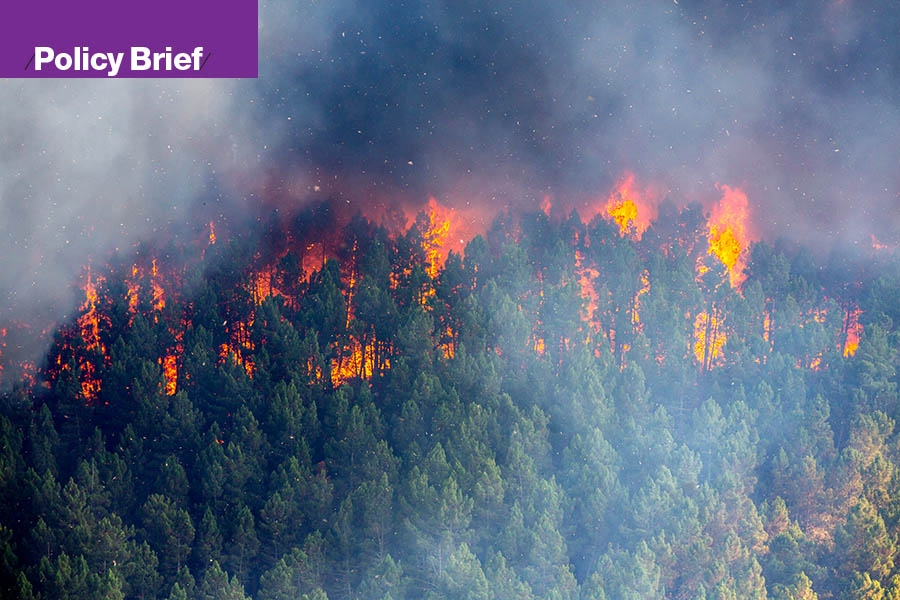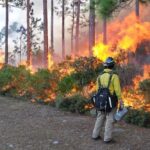Reducing ‘fuel’ from forests is critical to reducing the threat of wildfires.
What can we do to prevent out-of-control wildfires?
Nothing. Wildfires are as inevitable as any natural disaster. But that does not mean we have to suffer the consequences the way we do now.
Fire behavior is fundamentally regulated by topography, weather and fuels — the fire behavior triangle. Of these three sides, fuels are the only thing that we can actually manipulate to change fire behavior and reduce wildfire risk.
But this is good news relative to other natural disasters like hurricanes and floods, where humans can do nothing to change the event itself. Not only can we prepare for inevitable wildfire events in our future by reducing their fuel, we can diminish their power, their rate of spread and their ultimate impact.
Fuels reduction and management can be viewed as any designed treatment that alters living and dead fuels (down on the surface and up in the air) — their total amount, their relative position to one another, and their combustibility individually and in total.
An ideal fuels treatment in a forest or rangeland removes accumulated fuels (particularly the fine surface fuels), creates some separation among those fuels and between the surface and aerial fuels, and makes it all less available to burn.
We can do it with any combination of land management tools including cutting, mowing, chipping, spraying, pruning and … burning. Fire itself is a tool because it consumes the very fuel it needs to burn later.
Fuel management is not a huge, mysterious challenge. Our ancestors managed their landscapes very effectively to get the things they needed and reduce risk to their communities and lands.
For thousands of years they maintained a more open, fuel-limited landscape; wildfire behavior was therefore fuel limited. Wildfire today, however, is fuel rich after more than a century of European settlement that limited fire with: 1) introduction of extensive domestic grazing that consumed fuel; 2) concentrated human settlements and infrastructure; and 3) creation of organized fire suppression.
By the 1960s, suppression was highly effective at keeping most fires small, aided by a relatively cool, moist climatic period.
This history is the foundation from which out-of-control wildfires have emerged, in which fire-adapted landscapes now ironically become the victim of large wildfires and burn into our communities. A resistant/resilient landscape developed and sustained for millennia now burns uncharacteristically and destructively.
The interdependent processes of regeneration, growth and mortality activated by fire, and which formed a “memory” on the land, are now being erased.
And our mistakes at small scale have compounded over generations and careers, and across whole landscapes and ownerships.
The solution to changing this new pattern is in addressing the fuels, and understanding the fuels in the context of their topography and climate/weather.
The fuels matrix starts with our homes and communities, including the wildland-urban interface and goes out into the wildlands. Management and businesses will play a role in addressing all of these, as will private citizens and government.
When we see it all as fuel, we can manage that fuel over a significant area to reduce risk, particularly in light of climatic conditions and the realities of resource availability during fire seasons.
All landowners will need to do their parts within their missions to sustain their lands. These include homeowners, neighborhood associations, communities, small woodland owners/families, forest industry, Tribes, states and federal partners. Neighbors often burn or survive as a unit, so we stand or fall together.
The work will include equipment and trucks and noise and inconvenience and everything needed to do the job; it will include both government and business communities incentivizing fire-adapted housing, communities, rangelands and forests.
Some of the work can yield money and sustain industries, but some will cost money (a wise investment in the future). It will include much more prescribed fire and associated smoke on some days, but all this conservation work should be viewed positively, because it reflects future protection from wildfire and fewer weeks of hazardous smoke conditions and inconvenience later. And it might save some communities and some lives.
As the ash settles from this year, we need to acknowledge all the factors that have set up this situation, how it varies from one location to the next, and what different groups and individuals can do (and what needs to be sacrificed) for the common good.
In the end, we are exiting an era when wildfire was thought to be a distant, improbable and singular destructive event that could be stopped. In reality, and becoming more probable every year, wildfire is a commonly recurring natural phenomenon (both good and bad, both creative and destructive, both a tool and a disturbance) with which we must somehow coexist.
Fortunately, we have some excellent tools to both address and reduce our risk.
John Bailey is professor of silviculture and fire management at Oregon State University.
To subscribe to Oregon Business, click here.






